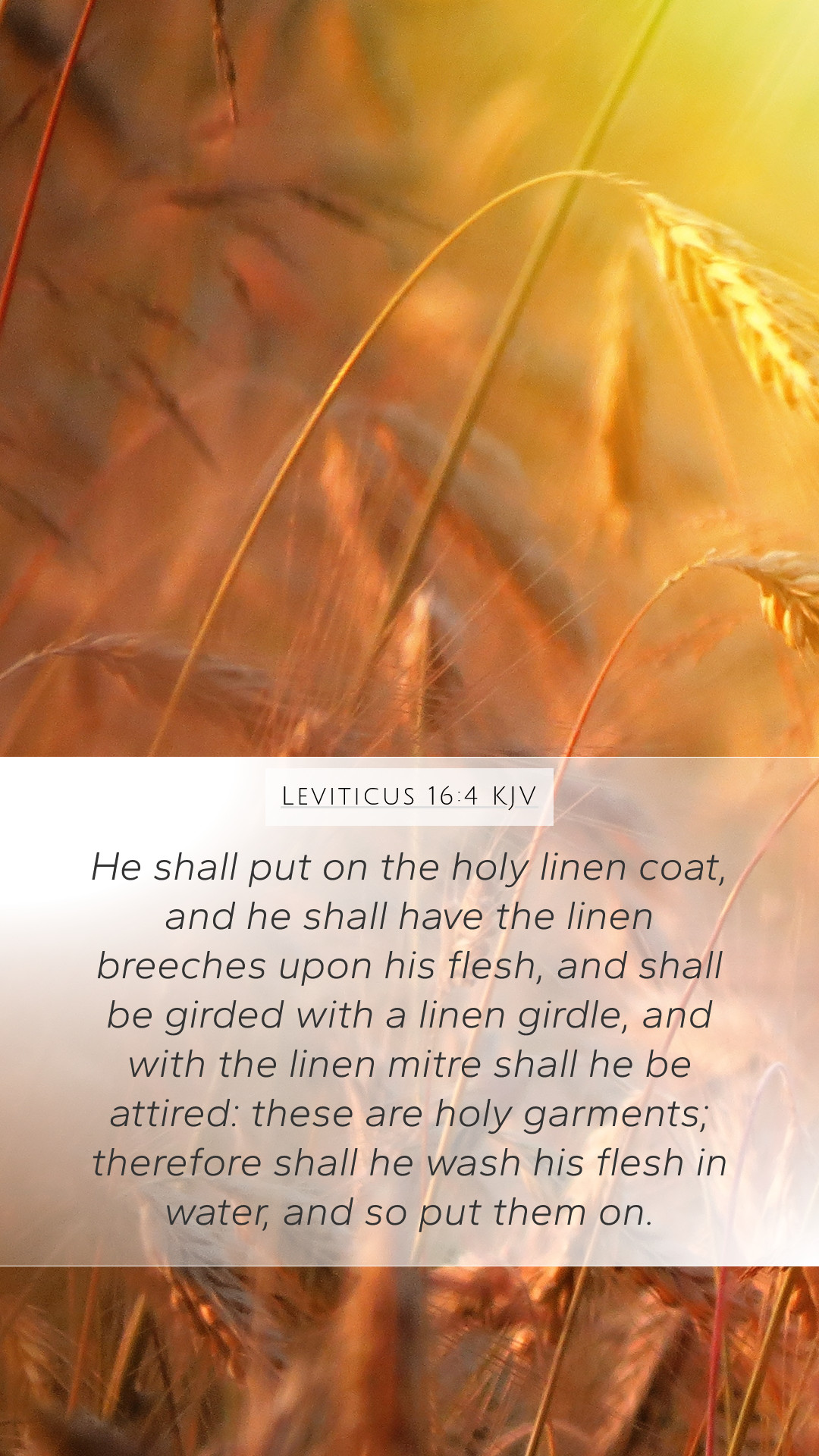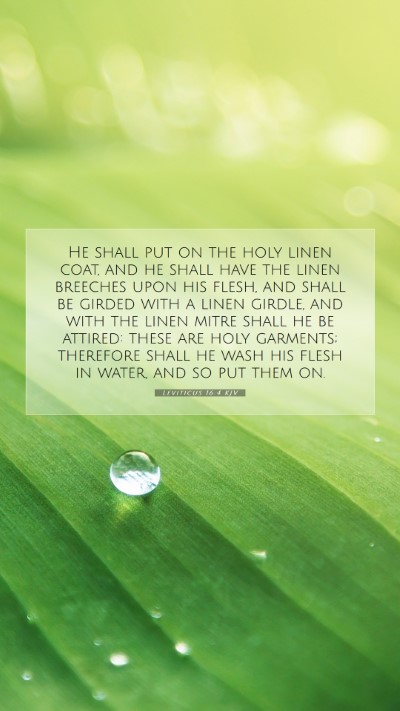Understanding Leviticus 16:4
Leviticus 16:4 states: "He shall put on the holy linen coat, and he shall have the linen breeches upon his flesh, and shall be girded with a linen girdle, and with the linen mitre shall he be attired: these are holy garments; therefore shall he wash his flesh in water, and so put them on." This verse offers profound insight into the sacrificial system and the role of the high priest in ancient Israel.
Bible Verse Meanings
The significance of this verse lies in its detailed description of the garments that the high priest must wear during the Day of Atonement. The emphasis on the holiness of these garments reflects the overall theme of Leviticus regarding purity and the necessity of approaching God in a state of holiness.
Insights from Commentaries
-
Matthew Henry's Commentary:
Matthew Henry emphasizes the necessity of holiness in the priestly duties. He notes that the garments symbolize the requirement for purity when approaching God. The linen fabric illustrates the priests' duty to maintain spiritual and physical cleanliness.
-
Albert Barnes' Commentary:
Albert Barnes discusses the significance of the high priest's attire, which was specifically designed for the highest and most solemn rituals of atonement. The linen material suggests simplicity and purity, contrasting with the elaborate adornments often associated with wealth and pride.
-
Adam Clarke's Commentary:
Adam Clarke elaborates on the historical context of these garments, relating them to the broader ceremonial practices of the Israelites. He highlights that the requirement of washing before donning the garments underscores the importance of ceremonial purity.
Thematic Elements
Leviticus 16:4 focuses on several crucial themes:
- Holiness: The high priest’s garments are described as "holy," emphasizing the sacredness of the role.
- Purification: The requirement to wash before putting on the garments signifies the need for purification before engaging in sacred duties.
- Approach to God: This verse illustrates the careful measures taken to ensure that the high priest could approach God, reflecting the gravity and solemnity of the priestly role.
Biblical Exegesis and Analysis
Through deep analysis of this verse, one can interpret the importance of ritual purity in the context of Old Testament worship. The high priest serves as an intermediary between God and the people, and the meticulous nature of his attire and preparation signifies the seriousness of this role. The rituals surrounding the Day of Atonement are foundational to understanding the broader narrative of sacrifice and redemption in Scripture.
Application of Bible Verses to Daily Life
Leviticus 16:4 invites contemporary readers to consider the importance of approaching God with reverence and preparation. This can manifest in several ways:
- Personal Purity: Seeking to live a life that is clean and holy in thoughts and actions, akin to the priest's preparation.
- Intentionality in Worship: Engaging in worship with a heart and spirit prepared to meet God.
- Service to Others: Understanding the role of an intermediary, and being proactive in serving as a bridge for others in faith.
Related Cross References
- Exodus 28:2-4: Details the garments for the high priests.
- Hebrews 9:7: Discusses the Day of Atonement and the high priest’s role.
- Leviticus 21:10-12: Further instructions on the high priest's conduct and attire.
Scripture Study Insights
For those involved in Bible study groups or engaging in online Bible study, Leviticus 16:4 serves as a critical point for discussions around the Old Testament's approach to holiness, purification, and atonement. Utilizing Bible study guides and Bible study tools can deepen the understanding of historical context and the significance of priestly duties.
Conclusion
In summary, Leviticus 16:4 encapsulates vital principles of holiness, purification, and the role of the high priest. Understanding this verse is essential for those seeking to grasp the intricacies of Bible verse interpretations, scripture analysis, and biblical exegesis. The lessons derived from this passage not only enrich our understanding of the Old Testament but also enhance our personal spiritual practices and daily life applications.


